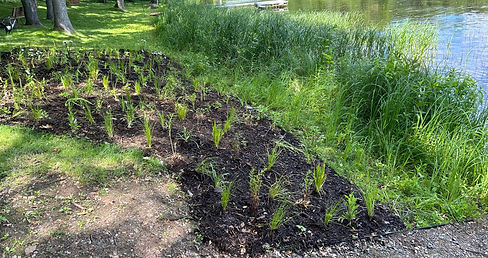
CONSERVATION
IN SMALL SPACES
Stormwater or Groundwater
When rain falls, in towns or urban areas, it either soaks into the ground to become groundwater or it flows on top of the ground and becomes stormwater runoff.
When water soaks into the ground, the soil acts as a “filter,” catching and holding onto almost anything that the rainwater is carrying. Native plant life can also capture the nutrients the water carries, much like a sponge. This is the ideal outcome for stormwater.
However, when stormwater can't seep into the ground, it will keep flowing above ground until it meets the nearest river, stream, or lake. Since this water had no opportunity to be filtered by the soil or native plants, it deposits whatever it grabs along the way into the body of water.

What does stormwater carry with it?
Stormwater runoff picks up whatever it comes in contact with as it travels to its lowest elevation. Soil, nutrients, manure, fertilizer, pet waste, trash, pesticides... storm water picks it all up. The contaminants that it picks up as it flows cause significant damage when it enters our waters.
Our lakes are becoming filled with stormwater runoff, which includes phosphorus and nitrates that cause major changes to the water quality and throw off the lake’s natural balance.
What Can You Do?
You can help lower the impacts of stormwater on your property and help keep our lakes and streams healthy by doing simple things to slow the flow of water.
Rain Gardens
Rain Barrels
Native Plantings
Animal Waste Management
Lake/Streambank Stabilization

Rain Gardens
A large way both municipalities and homeowners can begin to address stormwater problems is through rain gardens. It seems simple, but strategically placed rain gardens can be very effective. Rain gardens can trap and use most or all of the water your yard captures from an average storm. The yellow highlighted areas in the graphic show possible locations for effective rain gardens.

Rain Barrels
A typical house has a roof area of 1,200 square feet and four downspouts that will each drain about 300 square feet of roof. That means a rainfall of 0.3 inches will fill a 55-gallon rain barrel placed under each downspout.
Rain barrels or cisterns are above-ground water storage vessels. They capture rain runoff from a building’s roof using the gutter and downspout system.
The addition of a rain barrel to a storm water landscaping plan provides a great way to conserve water. It becomes a free water source for use around the yard. Rainwater collected in a rain barrel can be used for watering gardens, trees, the lawn, or washing a car.

Native Planting
A strip or area of native plants strategically planted on a stream or lake shoreline. Buffers protect your shoreline and help filter out potential pollutants.
Animal Waste Management
Picking up your pet’s waste (yes, we mean poop) prevents it from being washed into lake and streams and becoming where it becomes food for algae.

Shoreline Stabilization
Where shorelines are eroding, work with your local SWCD to learn different methods of restoring your shore. They can help you with local and state regulations, plus give you insights on what works well in our area.
Slow the Flow
Slowing and absorbing stormwater runoff is critical to protecting water quality.
Broken walkway and driveway surfaces, like stone or pebble, allow water to better soak into the ground.
The deep roots of trees and native plants act as a sponge, soaking up stormwater runoff.
Possibly the most effective and beautiful way to slow stormwater is with a rain garden. Strategically placed rain gardens do a fantastic job of soaking up excess water.

